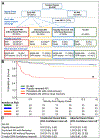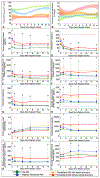Clinical Trajectories of Acute Kidney Injury in Surgical Sepsis: A Prospective Observational Study
- PMID: 33196489
- PMCID: PMC8116352
- DOI: 10.1097/SLA.0000000000004360
Clinical Trajectories of Acute Kidney Injury in Surgical Sepsis: A Prospective Observational Study
Abstract
Objective: To characterize endothelial function, inflammation, and immunosuppression in surgical patients with distinct clinical trajectories of AKI and to determine the impact of persistent kidney injury and renal non-recovery on clinical outcomes, resource utilization, and long-term disability and survival.
Summary of background data: AKI is associated with increased healthcare costs and mortality. Trajectories that account for duration and recovery of AKI have not been described for sepsis patients, who are uniquely vulnerable to renal dysfunction.
Methods: This prospective observational study included 239 sepsis patients admitted and enrolled between January 2015 and July 2017. Kidney Disease: Improving Global Outcomes (KDIGO) and Acute Disease Quality Initiative (ADQI) criteria were used to classify subjects as having no AKI, rapidly reversed AKI, persistent AKI with renal recovery, or persistent AKI without renal recovery. Serial biomarker profiles, clinical outcomes, resource utilization, and long-term physical performance status and survival were compared among AKI trajectories.
Results: Sixty-two percent of the study population developed AKI. Only one-third of AKI episodes rapidly reversed within 48 hours; the remaining had persistent AKI, among which 57% did not have renal recovery by discharge. One-year survival and proportion of subjects fully active 1 year after sepsis was lowest among patients with persistent AKI compared with other groups. Long-term mortality hazard rates were 5-fold higher for persistent AKI without renal recovery compared with no AKI.
Conclusions: Among critically ill surgical sepsis patients, persistent AKI and the absence of renal recovery are associated with distinct early and sustained immunologic and endothelial biomarker signatures and decreased long-term physical function and survival.
Copyright © 2020 Wolters Kluwer Health, Inc. All rights reserved.
Conflict of interest statement
The authors report no conflicts of interest.
Figures


References
-
- Bellomo R, Kellum JA, Ronco C, et al. Acute kidney injury in sepsis. Intensive Care Med. 2017;43(6):816–828. - PubMed
Publication types
MeSH terms
Substances
Grants and funding
LinkOut - more resources
Full Text Sources
Medical
Research Materials

